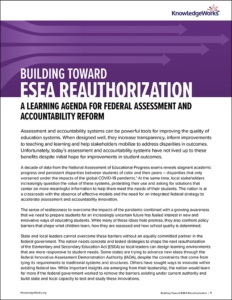Accelerating Assessment and Accountability Innovation
Recommendations for states leading the future of student-centered school quality systems
A decade of data from the National Assessment of Educational Progress shows little overall progress in improvement of student outcomes and persistent disparities between student subgroups – disparities that worsened under the global COVID-19 pandemic. Further, the pandemic revealed the weaknesses of the system by eliminating the main input used to determine school quality: standardized summative assessments. Schools, districts and states are increasingly seeking innovative learning models to drive deeper learning and find traditional assessments a consistent barrier to implementation. Now more than ever, parents and the public want consistent access to meaningful data about how schools are serving young people. This moment is an inflection point for the nation’s approach to understanding the quality of schools.
States are uniquely positioned within this work. While states have both the authority and responsibility for the provision of public education, much of what governs a state’s actions around assessments and accountability is mandated by the federal Elementary and Secondary Education Act (ESEA). Though the reauthorization of this law is not yet imminent, it is on the horizon. That means now is the opportune moment to rethink state assessment and accountability systems. State leaders should understand that federal lawmakers are seeking examples of states leading this work as well as asking questions about what states need to truly innovate within their assessment and accountability systems. Actions that states take now will support improvements in the near term and serve as critical proof points for federal leaders as they develop the next major iteration of national education law.
We invite state leaders to think differently about assessment and accountability to build a visionary foundation for the future.
States may address the above concerns by forming new relationships and mechanisms for collaboration to determine and improve school quality. In this reimagination, decision-making centers those closest to the classroom: students, families and teachers. System leaders begin to function more as facilitators and conveners to support local communities in the process of understanding school quality. State leaders are responsible for maintaining a system-wide lens for quality implementation and the equitable allocation of resources and supports. States are also well positioned to establish and support statewide learning communities, so that local communities may gather to learn from each other.
By building new infrastructure for collaboration around school quality, states will have a more authentic sense for how to make school quality and improvement efforts more meaningful for the local learning community. If leaders take up this work with intention, states can develop a new approach to assessment and accountability built on public trust and deep collaboration with those closest to the work.
Federal law requires states to assess all students annually in grades three through eight; once in high school in reading and math; and once at the elementary, middle and high school levels for science.
To meet these requirements, states have turned to standardized summative assessments citing their cost-effectiveness and alignment with federal peer review guidelines for technical quality. Specifically, standardized tests are valued under current guidelines for their provision of validity, reliability and comparability.
However, stakeholders have increasingly questioned the value of these assessments, pointing to unintended consequences such as lost instructional time and narrowing of the curriculum. Though states must still comply with federal requirements, there are key actions they can take now to make current assessment systems more meaningful and begin to build a case for future federal improvements.
Current assessment systems must evolve to live up to their original promise as a tool for helping educators and leaders improve the quality of classroom instruction. States have already begun to explore innovative assessment approaches that can reduce overreliance on summative standardized tests, provide a more meaningful assessment experience for students and produce the data that teachers need to inform instruction. The following set of recommendations aims to provide states with key actions to improve assessments in compliance with federal law.
States can begin to build innovative assessment systems that reduce the footprint of state summative tests – making room for local assessment that equips educators to drive meaningful, student-centered learning. By building assessment literacy for educators, states can work to infuse the system with technical quality (validity, reliability, comparability, etc.) without relying solely on standardized assessments. By thinking creatively about the articulation of competency-aligned standards, states can develop assessments aligned to real-world skills with greater flexibility in the assessment design process.
At the same time, truly innovative approaches can be built and tested in graduation requirements as well as state-issued assessments that are not bound by federal law. This may include the exploration of performance assessments or administering assessments using innovative sampling techniques. States may also consider refining approaches to collaborative scoring to increase teacher professional collaboration and ensure reliability within the assessment system.
By advancing these strategies, states can drive a necessary learning agenda to bolster the case for new ways of assessing learning.
States are required to report to the public on the quality of schools as well as to identify and provide supports to schools in improvement. These requirements are rooted in several decades of federal accountability reform that most recently requires states to identify the lowest performing schools in the state and oversee school improvement processes. After a 20-year investment in this strategy, evidence shows that results have not gotten better and, in fact, that disparities between student subgroups have gotten worse. At the same time, there is evidence that the data produced by these systems contributes to stigmatization of the communities it was intended to serve.
While conversations about the need to redesign accountability systems have grown in recent years, they are now at a boiling point due to the COVID-19 pandemic disruptions which suspended standardized testing data – the historically favored source of information on school quality – at a time when families and communities craved more information about schools.
States have an opportunity to turn immense public energy around school quality into momentum to redesign state accountability systems. By moving to a more holistic approach, accountability systems can locate specific strengths and weaknesses of each school, making improvement efforts more meaningful.
To be successful in this effort, it is imperative for states to think creatively and ensure broad collaboration with the public. Creativity is critical as states navigate existing federal law with increased public demand for a richer picture of school quality. At the same time, public demands for transparency around school performance have never been louder; states must ensure that those closest to the work are included in every stage of design and implementation of the new system.
The following series of recommendations provide initial strategies states can take as they begin to create a new path forward.
States are required by federal law to design accountability systems that measure school performance across a range of key indicators disaggregated by subgroup student populations.
However, states do have some autonomy within these requirements to determine school quality and student success indicators, how much various components of the system are valued, how the data are reported to the public and what actions happen as a result of accountability information. Even within the current federal requirements, states can design systems that provide the public with richer information as well as significantly more meaningful school improvement processes.
A number of states are beginning to consider improvements to their accountability systems to better reflect their vision for teaching and learning. States should consider networking with others to identify promising practices and serve as national thought leaders in the conversation about accountability redesign.
The COVID-19 pandemic laid bare the flaws of a system that relies on limited and inflexible data points to drive the most critical decisions about education. The public is demanding transparency and educators are working with student populations at dramatically different places in their learning. Within the boundaries of current federal law, states can undertake key actions to begin exploring more holistic approaches to assessment and accountability. States can demonstrate to federal leaders a strong desire for improvements in the next iteration of the nation’s K-12 education law.
The systems that are built today will be the foundation upon which the next reauthorization of ESEA is built. The time is now for innovative leaders to begin building the infrastructure for the assessment and accountability systems of the future.



With the support of their teacher, kindergarteners in this Arizona elementary school understand the standards they’re working through.

Five pieces of advice designed to help others overcome the potential hurdles faced during the first year or two of…
How one Arizona school is empowering educators, learners and families through a shift to standards-based grading
A future of learning where students of all races and ethnicities, incomes and identities pursue the kinds of learning experiences that enable them to uncover their passions and thrive in an evolving world.
Subscribe to receive email updates including expert insights, success stories and resources.